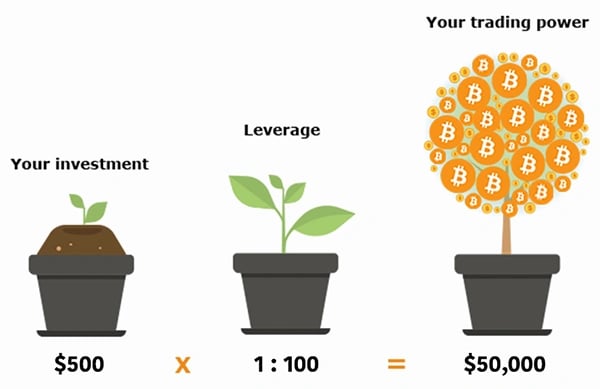위키 구독하기
Share wiki
Bookmark
Leverage
에이전트 토큰화 플랫폼 (ATP):에이전트 개발 키트(ADK)로 자율 에이전트 구축
Leverage
레버리지는 암호화폐와 같은 금융 자산 거래에 차입 자본을 사용하는 과정입니다. 레버리지는 트레이더의 매수 또는 매도 능력을 증폭시킵니다.[1][3]
1:5 (5x), 1:20 (20x) 또는 1:50 (50x)과 같은 레버리지 수준을 나타내는 비율은 초기 자본의 배수를 보여줍니다. 레버리지는 다양한 암호화폐 파생 상품 거래뿐만 아니라 마진 거래, 레버리지 토큰 또는 선물 계약에도 사용될 수 있습니다.[7]
레버리지 거래를 제공하는 몇몇 거래소로는 바이낸스(Binance), ByBit, 크라켄(Kraken), Phemex가 있습니다. 사용 가능한 옵션은 거래 수수료, 제공되는 최대 레버리지(2X에서 200X까지 다양함), 포지션을 유지할 수 있는 기간 등 여러 요소를 기준으로 비교할 수 있습니다.[5]
개요
레버리지 거래를 위해 사용자 거래 계정에 입금된 초기 자본은 담보로 알려져 있습니다. 필요한 담보는 사용된 레버리지와 열고자 하는 포지션의 총 가치(마진이라고 함)에 따라 달라집니다.
예를 들어, 사용자가 10배 레버리지를 사용하여 이더리움 (ETH)에 1,000달러를 투자한다고 가정해 보겠습니다. 필요한 마진은 1,000달러의 1/10인 100달러가 되며, 사용자 계정에 담보로 100달러가 있어야 차입 자금을 사용할 수 있습니다. 20배 레버리지를 사용하는 경우 필요한 마진은 더 낮아집니다(1,000달러의 1/20 = 50달러). 그러나 레버리지가 높을수록 청산 위험이 높아집니다.

초기 마진 예치 외에도 거래에 대한 마진 한도를 유지하는 것도 필수적입니다. 시장이 사용자의 포지션에 반대로 움직이고 마진이 유지 한도 미만으로 떨어지면 청산을 피하기 위해 계정에 더 많은 자금을 투자해야 합니다.
레버리지 매수 포지션
매수 포지션을 열면 자산 가격이 상승할 것으로 예상하는 것을 의미합니다.
사용자가 10배 레버리지를 사용하여 10,000달러 상당의 BTC 매수 포지션을 열려면 1,000달러를 담보로 사용해야 합니다. BTC 가격이 20% 상승하면 (수수료 제외) 2,000달러의 순이익이 발생하는데, 이는 레버리지 없이 1,000달러의 자본으로 거래했을 때 얻을 수 있는 200달러보다 훨씬 높습니다.
그러나 BTC 가격이 20% 하락하면 포지션은 2,000달러 손실을 보게 됩니다. 초기 자본(담보)이 1,000달러에 불과하므로 20% 하락하면 청산(잔액이 0이 됨)이 발생합니다. 정확한 청산 가치는 사용하는 거래소에 따라 다릅니다.
청산을 피하려면 담보를 늘리기 위해 지갑에 더 많은 자금을 추가해야 합니다. 대부분의 경우 거래소는 청산 전에 마진 콜을 보냅니다(예: 더 많은 자금을 추가하라는 이메일).
레버리지 매도 포지션
반면에 매도 포지션을 열면 자산 가격이 하락할 것으로 예상하는 것을 의미합니다.
사용자가 10배 레버리지를 사용하여 10,000달러 상당의 BTC 매도 포지션을 열려면 다른 사람에게서 BTC를 빌려 현재 시장 가격으로 매도해야 합니다. 담보는 1,000달러이지만 10배 레버리지를 사용하여 거래하므로 10,000달러 상당의 BTC를 매도할 수 있습니다.
현재 BTC 가격이 40,000달러라고 가정하면 0.25 BTC를 빌려 매도합니다. 가격이 20% 하락하여 32,000달러가 되면 0.25 BTC를 8,000달러에 되살 수 있습니다. 이는 (수수료 제외) 2,000달러의 순이익을 가져다줍니다.
그러나 BTC 가격이 20% 상승하여 48,000달러가 되면 0.25 BTC를 되사기 위해 추가로 2,000달러가 필요합니다. 이 경우 사용자의 포지션은 계정 잔액이 1,000달러에 불과하므로 청산됩니다. 청산을 피하려면 지갑에 더 많은 자금을 추가하여 담보를 늘려야 합니다.[4]
레버리지 거래
마진 거래 및 암호화폐 레버리지
마진 거래를 통해 트레이더는 기존 암호화폐 보유량을 담보로 자금을 빌릴 수 있으며, 본질적으로 구매력을 증폭시킵니다. 이 차입 자본을 통해 자신의 자산만으로는 가능하지 않았을 더 큰 포지션을 열 수 있습니다.
예를 들어, 1 비트코인을 보유한 트레이더는 10배 레버리지를 활용하여 10개 비트코인에 해당하는 포지션을 열 수 있습니다.
그러나 이러한 노출 증가는 위험 증가를 수반합니다. 증폭된 이익의 잠재력이 존재하지만 시장의 약간의 하락으로 상당한 손실이 발생할 수 있습니다.
레버리지 토큰
레버리지 토큰은 레버리지를 더욱 접근 가능하고 사용자 친화적으로 만들기 위해 도입되었습니다. 이러한 토큰은 사용자가 직접 마진 거래에 참여할 필요 없이 기초 자산의 일일 가격 변동의 배수를 추적합니다.
예를 들어, 3배 레버리지 비트코인 토큰은 비트코인의 일일 가격 변동 비율의 세 배를 목표로 합니다. 이는 트레이더가 마진 포지션의 복잡성을 처리하지 않고도 레버리지 노출을 얻을 수 있는 더 간단한 방법을 제공합니다.
탈중앙화 금융(DeFi) 및 탈중앙화 레버리지
탈중앙화 금융(DeFi) 플랫폼은 레버리지를 한 단계 더 발전시켰습니다. 스마트 계약을 통해 사용자는 자신의 암호화폐 자산을 담보로 잠그고 다른 자산을 빌릴 수 있으며, 탈중앙화 생태계 내에서 효과적으로 레버리지를 사용하여 거래할 수 있습니다. 이를 통해 사용자는 중앙화된 거래소나 기존 금융 기관에 의존하지 않고도 레버리지에 접근할 수 있습니다.[6]
레버리지 거래 대비 레버리지 없는 거래
레버리지 거래는 투자자 또는 트레이더가 자금을 빌려 거래 포지션을 늘리는 것을 포함하며, 잠재적 이익과 손실 모두를 증폭시킬 수 있습니다. 반대로 레버리지 없는 거래는 투자자 또는 트레이더가 추가로 빌린 자금 없이 개인적으로 소유한 자본만을 사용하는 경우 발생합니다.
예를 들어, 사용자가 8,000달러를 보유하고 있으며 BTC의 최근 거래 가격이 8,000달러라고 가정해 보겠습니다.
다음 날 BTC 가격이 8,050달러로 상승하는 경우:
- 레버리지 없음: 8,000달러에 1 BTC 계약을 매수하고 8,050달러에 매도하여 50달러의 이익을 얻습니다.
- 레버리지 있음: 8,000달러에 80,000달러 상당의 계약을 매수하고 8,050달러에 매도합니다. 10배 레버리지를 사용하여 거래하므로 이익이 10배 증폭되어 500달러가 됩니다.
그러나 다음 날 BTC 가격이 7,950달러로 하락하는 경우:
- 레버리지 없음: 8,000달러에 1 BTC 계약을 매수하고 7,950달러에 매도하여 50달러의 손실을 봅니다.
- 레버리지 있음: 8,000달러에 80,000달러 상당의 계약을 매수하고 7,950달러에 매도합니다. 10배 레버리지를 사용하여 거래하므로 손실이 10배 증폭되어 500달러가 됩니다.[2]
잘못된 내용이 있나요?
